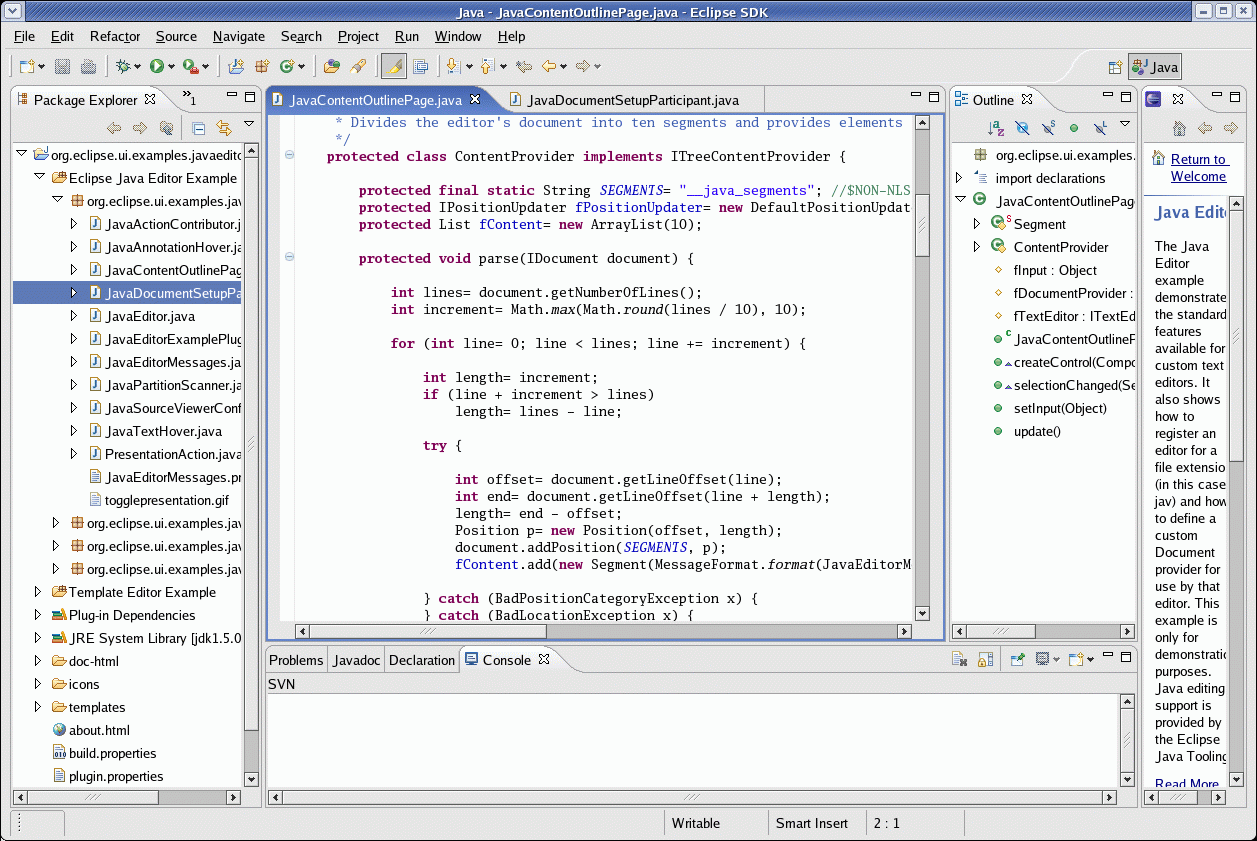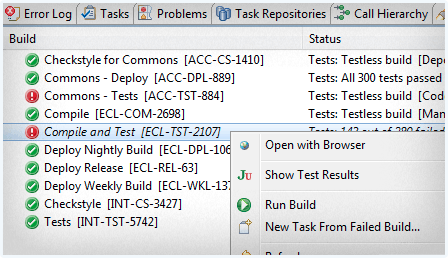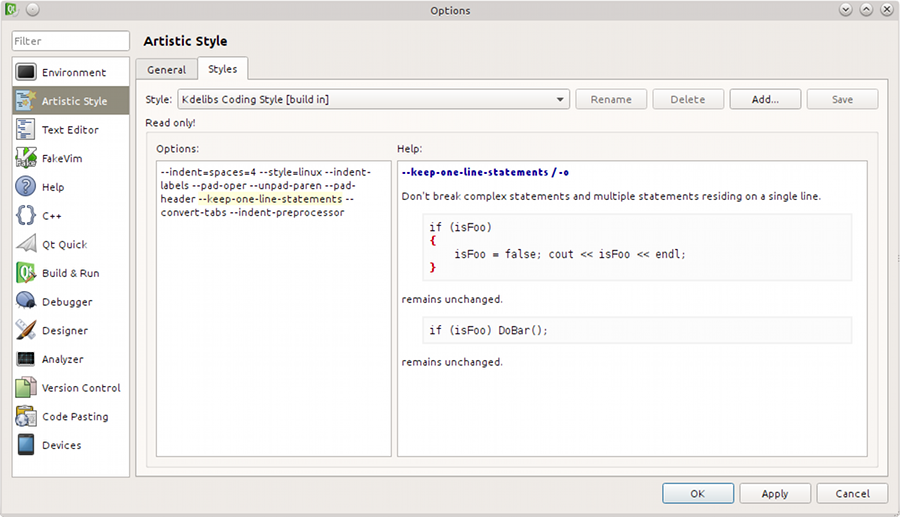Eclipse is an open source, multiplatform and totally free graphical software implemented in Java and designed from the offset to act as a universal, intuitive, powerful, highly customizable and highly extensible development platform and application framework for building software.
Features at a glance
The application offers all the necessary frameworks and tools that one needs for developing Java software, including support for modeling, performance and testing, rich client applications, embedded development, business intelligence, as well as language development environments for Java, C, C++ and programming languages.
Elipse is distributed into multiple editions, for Java developers, for Java EE developers, for C and C++ developers, for PHP developers, for Eclipse Committers 4.4.1, for Java and DSL developers, for Java and Report developers, for parallel application developers, for scout developers, for RCP and RAP developers, for testers and for automotive software developers. Additionally, modelling tools are also available for download.
Its graphical user interface looks exactly like a powerful IDE (Integrated Development Environment) and resembles the look and feel of other similar product that most probably cost a lot of money and aren’t so flexibility and customizable as Eclipse is. From the start, you will notice that all the tools and components are placed exactly where they should be, so you don’t have to spend a lot of time configuring the application instead of developing apps.
Under the hood and supported operating systems
Eclipse is a crossi-platform application written entirely in the Java programming language, meaning that it supports the GNU/Linux, Microsoft Windows and Mac OS X (Cocoa) OSes, as well as any other operating system where the Java SDK and JRE (Java Runtime Environment) are available.
To run it on your GNU/Linux machine, you will need to install Java SE 7 or greater. The project is compatible with both 32-bit and 64-bit instruction set architectures.
What is new in this release:
- Java developers can take advantage of new features in the Eclipse IDE, including new Quick Fixes for Java 8, a hierarchical presentation for nested projects in the Project Explorer, the ability to customize perspectives, and speed improvements for text search.
- The Linux Tools project now includes integrated tools that allow Eclipse users to build and manage Docker containers/images.
- A new project, called Oomph, makes it significantly easier to install an Eclipse IDE and to provision a project-specific Eclipse workspace. Oomph also makes it possible to record and share user preference settings across workspaces.
- Eclipse users will now be able to benefit from first-class Gradle support inside the Eclipse IDE. The new project, Buildship, makes it possible for developers to set up, configure, and initiate Gradle builds from Eclipse.
- Improved Maven support makes it easier for developers to use Maven from Eclipse. The new release includes support for Maven 3.3.3, improved Maven archetypes integration, enhanced auto-completion in the pom editor, and experimental support for automatic configuration updates.
- Sirius 3.0 introduces new usability features to help users create diagrams, significant performance gains for large models, and improvements to the query language that makes it easier to write and validate expressions.
- The Jubula project has released a Client API that allows developers to create test cases in Java. This allows Java developers to develop and maintain test cases in Eclipse and store those test cases in code repositories, such as Git.
- In an effort to improve the quality of all Eclipse projects, a new automated error reporting feature has been added to the Eclipse packages. If an error occurs in Eclipse, the user will be prompted to automatically send an error report to the appropriate Eclipse project team.
- An early access version of the JavaTM 9 support in Eclipse is available on the Eclipse Marketplace. This will allow Eclipse users to use Java 9 in the Eclipse IDE.
What is new in version :
- Java developers can take advantage of new features in the Eclipse IDE, including new Quick Fixes for Java 8, a hierarchical presentation for nested projects in the Project Explorer, the ability to customize perspectives, and speed improvements for text search.
- The Linux Tools project now includes integrated tools that allow Eclipse users to build and manage Docker containers/images.
- A new project, called Oomph, makes it significantly easier to install an Eclipse IDE and to provision a project-specific Eclipse workspace. Oomph also makes it possible to record and share user preference settings across workspaces.
- Eclipse users will now be able to benefit from first-class Gradle support inside the Eclipse IDE. The new project, Buildship, makes it possible for developers to set up, configure, and initiate Gradle builds from Eclipse.
- Improved Maven support makes it easier for developers to use Maven from Eclipse. The new release includes support for Maven 3.3.3, improved Maven archetypes integration, enhanced auto-completion in the pom editor, and experimental support for automatic configuration updates.
- Sirius 3.0 introduces new usability features to help users create diagrams, significant performance gains for large models, and improvements to the query language that makes it easier to write and validate expressions.
- The Jubula project has released a Client API that allows developers to create test cases in Java. This allows Java developers to develop and maintain test cases in Eclipse and store those test cases in code repositories, such as Git.
- In an effort to improve the quality of all Eclipse projects, a new automated error reporting feature has been added to the Eclipse packages. If an error occurs in Eclipse, the user will be prompted to automatically send an error report to the appropriate Eclipse project team.
- An early access version of the JavaTM 9 support in Eclipse is available on the Eclipse Marketplace. This will allow Eclipse users to use Java 9 in the Eclipse IDE.
What is new in version 4.7:
- Java developers can take advantage of new features in the Eclipse IDE, including new Quick Fixes for Java 8, a hierarchical presentation for nested projects in the Project Explorer, the ability to customize perspectives, and speed improvements for text search.
- The Linux Tools project now includes integrated tools that allow Eclipse users to build and manage Docker containers/images.
- A new project, called Oomph, makes it significantly easier to install an Eclipse IDE and to provision a project-specific Eclipse workspace. Oomph also makes it possible to record and share user preference settings across workspaces.
- Eclipse users will now be able to benefit from first-class Gradle support inside the Eclipse IDE. The new project, Buildship, makes it possible for developers to set up, configure, and initiate Gradle builds from Eclipse.
- Improved Maven support makes it easier for developers to use Maven from Eclipse. The new release includes support for Maven 3.3.3, improved Maven archetypes integration, enhanced auto-completion in the pom editor, and experimental support for automatic configuration updates.
- Sirius 3.0 introduces new usability features to help users create diagrams, significant performance gains for large models, and improvements to the query language that makes it easier to write and validate expressions.
- The Jubula project has released a Client API that allows developers to create test cases in Java. This allows Java developers to develop and maintain test cases in Eclipse and store those test cases in code repositories, such as Git.
- In an effort to improve the quality of all Eclipse projects, a new automated error reporting feature has been added to the Eclipse packages. If an error occurs in Eclipse, the user will be prompted to automatically send an error report to the appropriate Eclipse project team.
- An early access version of the JavaTM 9 support in Eclipse is available on the Eclipse Marketplace. This will allow Eclipse users to use Java 9 in the Eclipse IDE.
What is new in version 4.5.2:
- Java developers can take advantage of new features in the Eclipse IDE, including new Quick Fixes for Java 8, a hierarchical presentation for nested projects in the Project Explorer, the ability to customize perspectives, and speed improvements for text search.
- The Linux Tools project now includes integrated tools that allow Eclipse users to build and manage Docker containers/images.
- A new project, called Oomph, makes it significantly easier to install an Eclipse IDE and to provision a project-specific Eclipse workspace. Oomph also makes it possible to record and share user preference settings across workspaces.
- Eclipse users will now be able to benefit from first-class Gradle support inside the Eclipse IDE. The new project, Buildship, makes it possible for developers to set up, configure, and initiate Gradle builds from Eclipse.
- Improved Maven support makes it easier for developers to use Maven from Eclipse. The new release includes support for Maven 3.3.3, improved Maven archetypes integration, enhanced auto-completion in the pom editor, and experimental support for automatic configuration updates.
- Sirius 3.0 introduces new usability features to help users create diagrams, significant performance gains for large models, and improvements to the query language that makes it easier to write and validate expressions.
- The Jubula project has released a Client API that allows developers to create test cases in Java. This allows Java developers to develop and maintain test cases in Eclipse and store those test cases in code repositories, such as Git.
- In an effort to improve the quality of all Eclipse projects, a new automated error reporting feature has been added to the Eclipse packages. If an error occurs in Eclipse, the user will be prompted to automatically send an error report to the appropriate Eclipse project team.
- An early access version of the JavaTM 9 support in Eclipse is available on the Eclipse Marketplace. This will allow Eclipse users to use Java 9 in the Eclipse IDE.
What is new in version 4.5.1:
- Java developers can take advantage of new features in the Eclipse IDE, including new Quick Fixes for Java 8, a hierarchical presentation for nested projects in the Project Explorer, the ability to customize perspectives, and speed improvements for text search.
- The Linux Tools project now includes integrated tools that allow Eclipse users to build and manage Docker containers/images.
- A new project, called Oomph, makes it significantly easier to install an Eclipse IDE and to provision a project-specific Eclipse workspace. Oomph also makes it possible to record and share user preference settings across workspaces.
- Eclipse users will now be able to benefit from first-class Gradle support inside the Eclipse IDE. The new project, Buildship, makes it possible for developers to set up, configure, and initiate Gradle builds from Eclipse.
- Improved Maven support makes it easier for developers to use Maven from Eclipse. The new release includes support for Maven 3.3.3, improved Maven archetypes integration, enhanced auto-completion in the pom editor, and experimental support for automatic configuration updates.
- Sirius 3.0 introduces new usability features to help users create diagrams, significant performance gains for large models, and improvements to the query language that makes it easier to write and validate expressions.
- The Jubula project has released a Client API that allows developers to create test cases in Java. This allows Java developers to develop and maintain test cases in Eclipse and store those test cases in code repositories, such as Git.
- In an effort to improve the quality of all Eclipse projects, a new automated error reporting feature has been added to the Eclipse packages. If an error occurs in Eclipse, the user will be prompted to automatically send an error report to the appropriate Eclipse project team.
- An early access version of the JavaTM 9 support in Eclipse is available on the Eclipse Marketplace. This will allow Eclipse users to use Java 9 in the Eclipse IDE.
What is new in version 4.5:
- Java developers can take advantage of new features in the Eclipse IDE, including new Quick Fixes for Java 8, a hierarchical presentation for nested projects in the Project Explorer, the ability to customize perspectives, and speed improvements for text search.
- The Linux Tools project now includes integrated tools that allow Eclipse users to build and manage Docker containers/images.
- A new project, called Oomph, makes it significantly easier to install an Eclipse IDE and to provision a project-specific Eclipse workspace. Oomph also makes it possible to record and share user preference settings across workspaces.
- Eclipse users will now be able to benefit from first-class Gradle support inside the Eclipse IDE. The new project, Buildship, makes it possible for developers to set up, configure, and initiate Gradle builds from Eclipse.
- Improved Maven support makes it easier for developers to use Maven from Eclipse. The new release includes support for Maven 3.3.3, improved Maven archetypes integration, enhanced auto-completion in the pom editor, and experimental support for automatic configuration updates.
- Sirius 3.0 introduces new usability features to help users create diagrams, significant performance gains for large models, and improvements to the query language that makes it easier to write and validate expressions.
- The Jubula project has released a Client API that allows developers to create test cases in Java. This allows Java developers to develop and maintain test cases in Eclipse and store those test cases in code repositories, such as Git.
- In an effort to improve the quality of all Eclipse projects, a new automated error reporting feature has been added to the Eclipse packages. If an error occurs in Eclipse, the user will be prompted to automatically send an error report to the appropriate Eclipse project team.
- An early access version of the JavaTM 9 support in Eclipse is available on the Eclipse Marketplace. This will allow Eclipse users to use Java 9 in the Eclipse IDE.
What is new in version 4.4.1:
- Eclipse Luna includes official support for Java 8 in the Java development tools, Plug-in Development Tools, Object Teams, Eclipse Communication Framework, Maven integration, Xtext, Xtend, Web Tools Platform, and Memory Analyzer.
- Highlights:
- Java 8 support including language enhancements, search and refactoring, Quick Assist and Clean Up to migrate anonymous classes to lambda expressions and back, and new formatter options for lambdas.
- The Eclipse workbench provides a new dark theme which includes syntax highlighter settings for several programming languages.
- Paho provides open source implementations of open and standard messaging protocols that support current and emerging requirements of M2M integration with Web and Enterprise middleware and applications.
- The Eclipse Communication Project's (ECF) specification-compliant implementation of OSGi Remote Service/Remote Service Admin has been enhanced to support the use of Java 8's CompletableFuture for asynchronous remote services.
- Sirius allows architects to easily create their own graphical modeling workbenches by leveraging the Eclipse modeling technologies, including Eclipse Modeling Framework (EMF) and Graphical Modeling Framework (GMF). EcoreTools, the graphical modeler for Ecore, has been completely re-implemented based on Sirius.
Requirements:
- Java 2 Standard Edition Runtime Environment
- SWT




Comments not found